Chapter 7: Corporations and legal personality
Chapter learning objectives
Upon completion of this chapter you will be able to:
- explain the meaning and effect of limited liability
- explain meaning of LLPs and compare companies and partnerships
- analyse the different types of companies, especially public and private companies
- illustrate the effect of separate personality
- recognise instances where separate personality will be ignored
- explain the role and duties of company promoters
- describe the procedure for registering companies, both public and private
- describe the contents of model articles of association
- analyse the effect of a company's articles
- explain how articles of association can be changed
- describe the statutory books, records and returns that companies must keep or make.
1 The doctrine and veil of incorporation
Meaning
 The company is separate legal entity (i.e. separate from its shareholders, the part owners and its directors, the managers).
The company is separate legal entity (i.e. separate from its shareholders, the part owners and its directors, the managers).
Salomon v Salomon & Co Ltd (1897)
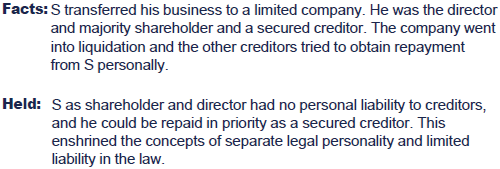
Lee v Lee's Air Farming Ltd (1960)
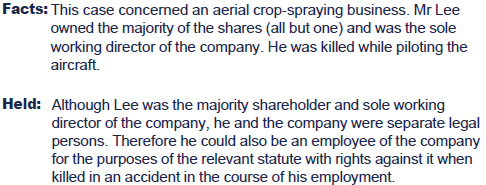
Macaura v Northern Life Assurance (1925)

Consequences of incorporation
There are a number of consequences of being a separate legal entity:
- Limited liability. A company is liable for its own debts. If a company fails, the liability of the shareholders is limited to any amount still unpaid on their share capital (or any amount they have agreed to contribute if the company is limited by guarantee).
- A company enters into contracts in its own name and can sue and be sued in its own name.
- A company owns its own property.
- A company has perpetual succession, irrespective of the fate of shareholders.
- The management of a company is separated from its ownership.
- A company is subject to the requirements of the Companies Act 2006 (CA06).
- Where a company suffers an injury, it is the company itself that must take the appropriate remedial action. This is known as the rule inFoss v Harbottle.
Foss v Harbottle (1843)

2 Lifting the veil of incorporation
Meaning
The phrase 'lifting the veil of incorporation' means that incertain circumstances the courts can look through the company to theidentity of the shareholders.
 The usual result of lifting the veil is that the members or directors become personally liable for the company's debts.
The usual result of lifting the veil is that the members or directors become personally liable for the company's debts.
Statutory examples
There are a number of occasions on which statute will intervene to lift the veil:
- S399 of CA06 requires accounts to be prepared by a group of related companies, therefore recognising the common link between them
- Under the Insolvency Act 1986 (IA 1986), members and/or directors liable for wrongful or fraudulent trading may be personally liable for losses arising as a result. (See chapter 13).
- If a public company starts to trade without first obtaining a trading certificate, the directors can be made personally liable for any loss or damage suffered by a third party: S767 CA06.
- Under the Company Directors Disqualification Act 1986, if a director who is disqualified participates in the management of a company, that director will be jointly or severally liable for the company's debts.
Case law examples
Sham companies
The veil will be lifted only where 'special circumstances exist indicating that it is a mere facade concealing the true facts': Woolfson v Strathclyde Regional Council (1978) For example:
Gilford Motor Co Ltd v Horne (1933)

Jones v Lipman (1962)

Nationality
In times of war it is illegal to trade with the enemy. It may bepossible to lift the veil of incorporation so as to impute to a companythe same nationality as its members.
Daimler v Continental Tyre & Rubber Co (1916)

Groups
Although each company within a group is a separate legal entity,there have been a number of cases where the courts have lifted the veilbetween a holding company and its various subsidiaries. This hasgenerally been done in order to:
- benefit the group by obtaining a higher compensation payment on the compulsory purchase of premises.
- benefit creditors of an insolvent company by making other companies within the group liable for its debts.
DHN Food Distributors v London Borough of Tower Hamlets (1976)
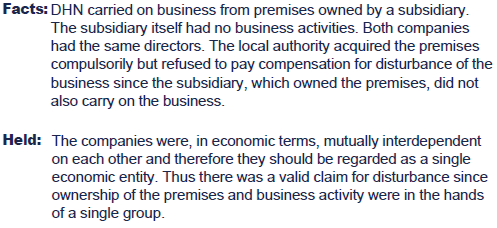
The above case can, however, be contrasted with the more recent case of Adams v Cape Industries (1990) which represents the current position:
Adams v Cape Industries (1990)


 Test your understanding 1
Test your understanding 1
In the context of company law explain:
Awhat is meant by, and the consequences of, the 'veil of incorporation'
Bunder what circumstances the 'veil' will be lifted.
(ACCA June 2003)

3 LLPs
Ordinary partnerships lack the characteristics of a company in thesense that they do not have limited liability or separate legalpersonality. Over the time the government was pressurised to recognisethe needs of some partnerships (especially professional partnership suchas solicitors, accountants and auditors) to limit their liability andhave separate legal personality without having to form a company. Thistrend resulted in a key development in the form of the Limited LiabilityPartnerships Act 2000. The Limited Liability Partnerships can be formedsince 6 April 2001 and have similar features to a private limitedcompany. The members of an LLP are not directly responsible for thedebts of the partnerships and the law relating to ordinary partnershipdoes not apply to them.
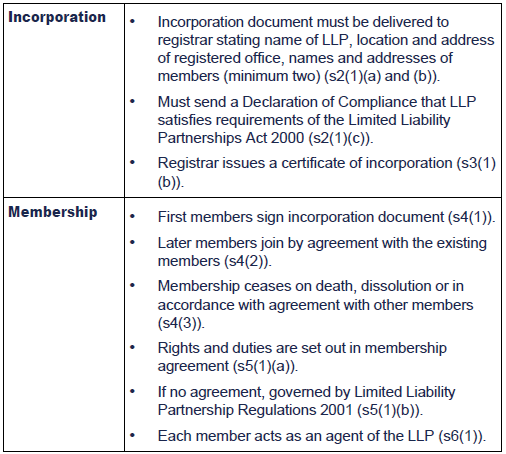

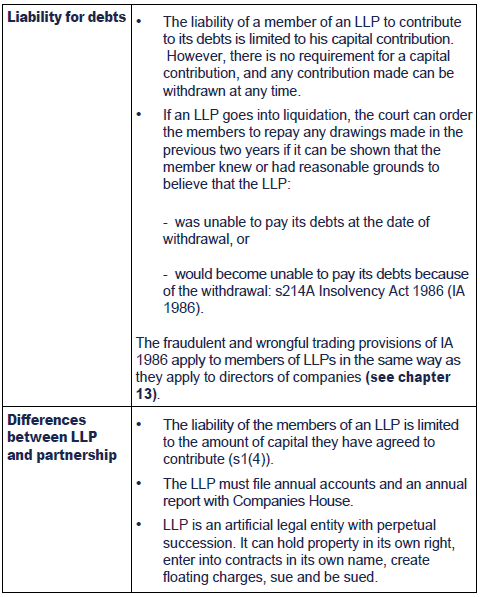
Company versus partnership

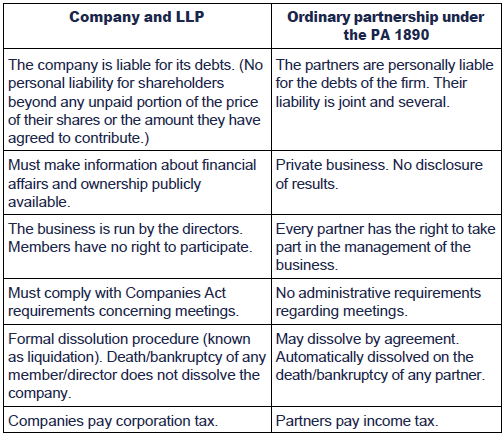

 Test your understanding 2
Test your understanding 2
(1)X Ltd, Y Ltd and Z Ltd haveformed the XYZ partnership. If the partnership should become insolvent,which of the following statements is correct?
AThe shareholders of each company are fully liable for the firm's debts.
BX Ltd, Y Ltd and Z Ltd are fully liable for the firm's debts.
CThe directors of each company are fully liable for the firm's debts.
DThe liability of X Ltd, Y Ltd and Z Ltd for the firm's debts is limited to the amount of their capital contributions.
(2)In relation to E Ltd, a company limited by shares, which one of the following statements is correct?
AThe liability of the company and its shareholders is limited, but the directors are fully liable for the company's debts.
BThe liability of the company and its directors is limited, but the shareholders are fully liable for the company's debts.
CThe liability of the company, its directors and shareholders is limited.
DThe liability of the directors and shareholders is limited, but the company is fully liable for its own debts.
(3)Mr X owns shares in Y Ltd. This means that Mr X:
Iis a part-owner of Y Ltd
II is a part-owner of Y Ltd's property.
Which of the above is/are correct?
AI. only.
BII. only.
CBoth I. and II.
DNeither I. nor II.

4 Types of company
Introduction
Private company versus public company
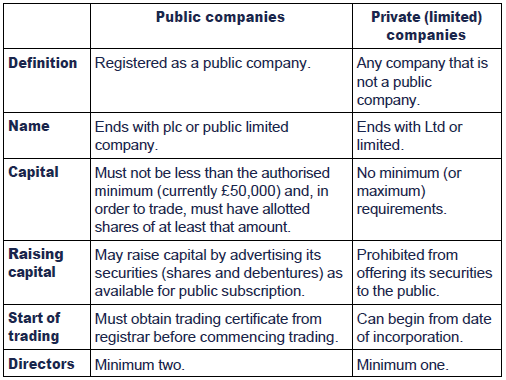


 Test your understanding 3
Test your understanding 3
(1)Which one of the following statements is incorrect in relation to a public company limited by shares?
AThe company must have at least one director.
BThe company must have at least two shareholders.
CThe company must have an allotted share capital of at least £50,000.
DThe company must be registered as a public limited company.
(2)What is the main requirement of the Companies Act 2006 relating to a private company?
AThe allotted capital must not exceed £50,000.
BIt must not have more than 50 members.
CThe liability of its members must be limited.
DIt must not invite the public to subscribe for its shares.
(3)Which of the following is a requirement for any public company?
ANo restrictions may be placed on the transfer of its shares.
BIts shares must be publicly for sale.
CIt must have a minimum paid up capital of £50,000.
DThe final words of the company's name must be 'public limited company' (or plc).


 Test your understanding 4
Test your understanding 4
Spencer and his brother Trevor have decided to leave theiremployment as software engineers and set up a consultancy. Spencer hascome to you for advice; he is unsure about the type of businessorganisation he should commence trading as.
A Fill in the gap, delete as appropriate and complete the sentence.
The term 'partnership' is defined in………………………..People can form such organisations informally or formally but theyneed/do not need written agreements.
The definition of a partnership is …
(Your answer must not exceed 20 words.)
B Fill in the gaps, delete as appropriate and complete the sentence.
The major advantage of incorporating a business is that the………………………..of the ………………………..is……………………….. On company insolvency, the amount theshareholders/directors can be obliged to contribute to the company'sassets is ….
(Your answer must not exceed 10 words.)
C Delete as appropriate and fill the gap.
The formalities required to form a company are less/more onerousthan for other types of business organisation. In addition there isless/more regulation in relation to the officers of a company comparedto partners. Partnerships are also less/more private in that they do/donot have to publish annual accounts.
D Spencer and Trevor may one day wish to become a public company. What are the main characteristics of this business entity?
(Your answer must not exceed 20 words.)

5 Promoters
Definition
 There is no statutory definition of a promoter.
There is no statutory definition of a promoter.
According to case law, a promoter is a person who 'undertakes toform a company and who takes the necessary steps to accomplish thatpurpose': Twycross v Grant (1878).
The definition excludes people just acting in a professional capacity, such as accountant or solicitor.
Duties

 Duties
Duties
It has long been established in Equity that certain relationshipsplace one party in a vulnerable position versus the other by virtue ofthe nature of the relationship. This usually occurs when one party hasthe power to deal with the affairs of the other party without beingsubjected to the full control of the other either due to impossibilityor impracticality. Such persons will be treated as being in a fiduciaryrelationship with the weaker party.
To prevent the stronger party from benefiting from such a position,Equity developed a set of strict rules which are consistently appliedto prevent a fiduciary from abusing their position of power.
The most common examples of fiduciary relationships are:
- trustees and beneficiary
- director and the company
- principal and agent
- partners in partnership
- promoters and the company.

A promoter is under a fiduciary duty to:
- disclose any interest in transactions to the company and not to make a 'secret profit'
- disclose any benefit acquired to an independent board and/or to the shareholders.
If a promoter does make a secret profit, the company may:
- Rescind the contract – but this is not always possible, e.g. if a third party has acquired rights under the contract.
- Obtain damages – but this requires the company to prove loss.
- Recover the profit – the company must prove that the promoter has failed to disclose his profit from a transaction.
Pre-incorporation contracts
A pre-incorporation contract is a contract made by a person acting on behalf of an unformed company.
 The position at common law is that a company, prior to itsincorporation, does not have contractual capacity and the promoter istherefore personally liable. (This is because a company does not legallyexist until it is incorporated.)
The position at common law is that a company, prior to itsincorporation, does not have contractual capacity and the promoter istherefore personally liable. (This is because a company does not legallyexist until it is incorporated.)
Kelner v Baxter (1866)

S51 CA06 reinforces the common law position by providing that,subject to any agreement to the contrary, the person making the contractis personally liable. Clear and express words are needed in order tonegate liability: Phonogram Ltd v Lane (1981).
The promoter can protect his position by:
- including a term in the contract giving the company the right to sue under the Contracts (Rights of Third Parties) Act 1999
- postponing finalising contracts until the company is formed
- entering into an agreement of novation (this involves discharging the original contract and replacing it with a new one) or assigning (transferring) the contract
- agreeing with the company that there is no personal liability for the promoter
- buying an 'off-the-shelf' company, so it is ready to contract without waiting for incorporation.
Off-the-shelf companies
An 'off-the-shelf' company is one that has already been formed. Buying off the shelf has a number of advantages as follows:
Advantages:
- cheap and simple
- can trade immediately
- no problem of pre-incorporation contracts.

 Test your understanding 5
Test your understanding 5
(1)Which of the following statements is true in respect of a promoter in breach of their duty not to make a secret profit?
AThe company can always sue the promoter for damages.
BThe company can only rescind the contract with the promoter when the promoter owned the property before the promotion began.
CThe company can always rescind the contract with the promoter.
DThe company can only rescind the contract with the promoter when the promoter acquired the property after the promotion began.
(2)Which of the following are correct?
IPurchasing an 'off-the-shelf' company enables a business to commence more quickly.
II It is generally cheaper to purchasean 'off-the-shelf' company than to arrange for a solicitor oraccountant to register a new company.
IIIIncorporating a company byregistration enables the company's documents to be drafted to theparticular needs of the incorporators.
AI and II only.
BII and III only.
CI and III only.
DI, II and III.
(3)A company's contractual capacity before incorporation is limited in that it may:
Aonly make contracts necessary to form the company.
Bonly ratify, once formed, contracts necessary to form the company.
Conly make or ratify, once formed, contracts necessary to form the company.
Dnot make or ratify, once formed, any contract even if necessary to form the company.
(4)Tom ordered goods from SellerLtd on behalf of H Ltd before H Ltd had obtained its certificate ofincorporation. Tom signed the order 'Tom, for and on behalf of H Ltd.'Upon receipt of a certificate of incorporation, the board of H Ltdagreed that the company should adopt the contract with Seller Ltd.
If the contract with Seller Ltd is broken, who is liable for the breach?
ATom.
BH Ltd.
CThe board of H Ltd.
DThe shareholders of H Ltd.


 Test your understanding 6
Test your understanding 6
Alfred and Betty have carried on a business as a partnership forsome years. They have now decided to incorporate their business.
A Explain the difference in liability for business debts between partners and shareholders.
(Your answer must not exceed 25 words)
B Fill in the gaps, delete as appropriate and complete the sentence.
Alfred bought some stationery on credit before the date ofincorporation. Alfred is/is not personally liable for the debt because………………………………………………………
(Your answer must not exceed 10 words)
The company can/cannot unilaterally adopt the contract.
A range of better solutions might have included………………………………………………………………………
(Your answer must not exceed 25 words)

6 Registration
Documents to registrar
The following must be submitted to the Registrar in order to form a company:
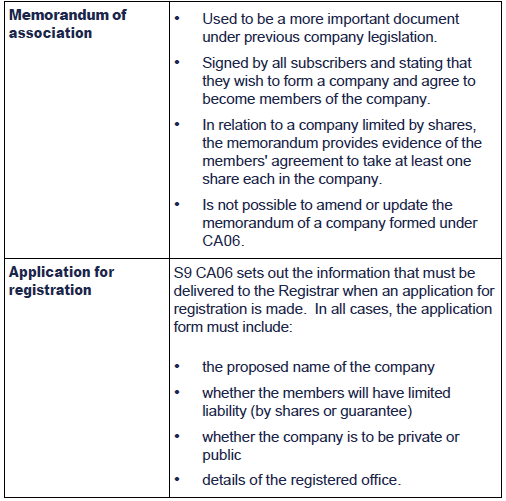
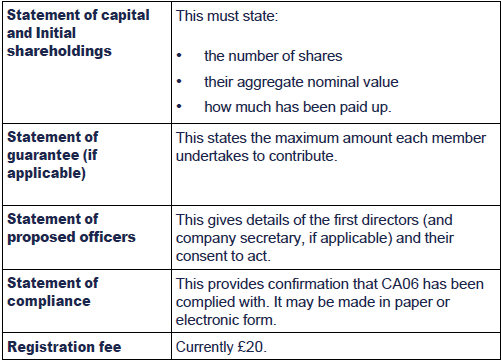
Note: As the model articles will apply if no articles aresupplied, it is not a requirement that articles must be sent, althoughall companies will have articles.
Registrar's duties
On receipt of the above documents the registrar must:
- Inspect the documents and ensure that Companies Act requirements are fulfilled.
- Issue certificate of incorporation which is conclusive evidence that Companies Act requirements have been fulfilled: s15 CA06. The company exists from the date on the certificate of incorporation.
Trading certificate – public companies only
A plc cannot commence trading until the registrar has issued a trading certificate.
In order to obtain a trading certificate, an application must be made to the registrar which states:
- The nominal value of allotted share capital ≥ £50,000.
- That at least a quarter of the nominal value and all of the premium have been paid up.
- The amount of preliminary expenses and who has paid or is to pay them.
- Any benefits given or to be given to promoters.
If it trades before the certificate is issued:
- The company and any officers in default are liable to a fine.
- It is a criminal offence to carry on business, but any contracts are still binding on the company.
- The directors are personally liable if the company defaults within 21 days of due date.
- It is a ground for winding up if not obtained within one year: s122 IA 1986.

 Test your understanding 7
Test your understanding 7
(1)Bob and Mike decided to form acompany. On 1 March 20X6, they sent the necessary documents to theregistrar. On 10 May 20X6, they received the certificate ofincorporation dated 1 May 20X6. Subsequently they discovered that thecompany was registered on 1 June 20X6.
What was the date of incorporation?
A1 March 20X6.
B1 May 20X6.
C10 May 20X6.
D1 June 20X6.
(2)The effect of a public company trading without a trading certificate is that:
Athe contracts are valid.
Bthe contracts are voidable at the option of the company.
Cthe contracts are voidable at the option of the third party.
Dthe contracts are void.
(3)Which of the following documents need not be submitted to register a company limited by shares?
AA memorandum of association.
BArticles of association.
CA statement of the first directors and secretary.
DA statutory declaration of compliance with the requirements of the Companies Acts.


 Test your understanding 8
Test your understanding 8
Adam and Ben have carried on business together in partnership for anumber of years. They have now decided to operate their businessthrough the medium of a private company limited by shares called AB Ltd.
AComplete this sentence.
As partners, the liability of Adam and Ben for the firm's debtswas……………………...…………………………………………
(Your answer must not exceed 3 words.)
BIn order to register a privatecompany limited by shares the partners will need to submit the followingdocuments to the registrar of companies.
CComplete this sentence:
If the Registrar of Companies is satisfied with the documentssubmitted to him for registration, he will issue a………………………. which enables the company to commencetrading immediately.
DExplain the liability of Adam and Ben in the event of AB Ltd becoming insolvent.
(Your answer must not exceed 20 words.)

Name of company
The name of the company must comply with the following rules:
- It must have limited (Ltd) or public limited company (plc) at the end as applicable.
- It cannot be the same as another in the index of names.
- it cannot use certain words which are illegal or offensive.
- It must have the Secretary of State's consent to use certain words (e.g. England, Chartered, Royal, National, University, Insurance, etc.) or any name suggesting a connection with the government or any local authority.
- It must avoid the tort of passing off (see chapter 3).
A company can voluntarily change its name by passing a specialresolution under s77 CA06 or by any other means provided for in thearticles.
The Secretary of State requires a company to change its name in the following circumstances:
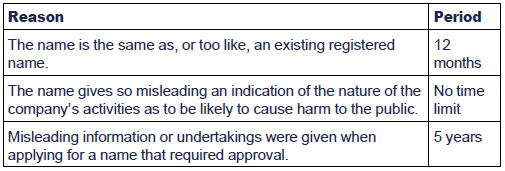

 Test your understanding 9
Test your understanding 9
(1)Which of the following namescould not without further consent be a permissible name under theCompanies Act for a company, the main object of which is to contractrefuse collection services for Westminster City Council?
AWestminster City Refuse Services Ltd.
BCouncil (Refuse Collection) Services Ltd.
CRefuse Collection (Westminster) Ltd.
DCity Waste Disposal Ltd.
(2)Which of the following statements is correct?
IIt is not possible to register a company limited by shares with the same name as a company already on the register.
II Once on the register, a company limited by shares cannot change its registered office.
AI. only.
BII. only.
CBoth I. and II.
DNeither I. nor II.
(3)A business has beenregistered under the name 'The Mark Jones Partnership Co Ltd'. What typeof business organisation must this be?
AA partnership.
BA private limited company.
CA public limited company.
DAny of the above as this is a business name.

7 Articles of association
Introduction
The articles of association form the company's internal constitution.
They:
- set out the manner in which the company is to be governed and
- regulate the relationship between the company and its shareholders.
There are no mandatory contents.
Model articles
For companies incorporated under Companies Act 2006, model articles have been prescribed by the Secretary of State.
There are three model articles which cover the following companies:
- private companies limited by shares; or
- private companies limited by guarantee; or
- public companies.
These model articles will apply where a company is formed withoutregistering articles or where the articles registered do not exclude ormodify the model articles.
A company:
- may adopt the model articles in full or in part;
- is deemed to have adopted the model articles if there is no express or implied provision to exclude them; or
- may draft its own unique articles
Companies Act 2006 states that the articles shoud be contained in asingle document which is divided into consecutively numberedparagraphs.
Articles should contain rules on a number of areas, the most important of which are as follows:
- Appointment and dismissal of directors
- Powers, responsibilities and liabilities of directors
- Director's meetings
- Member's rights
- Dividends
- Communication with members
- Issue of shares
- Documents and records
8 Legal effect of company's constitutional documents
S33 CA06 states that the provisions of a company's constitutionbind the company and its members to the same extent as if there werecovenants on the part of the company and of each member to observe thoseprovisions. This means that the articles form a contract between thecompany and its members, and the members between themselves, even ifthey do not sign them.
(1)The articles are in all respects enforceable by the company against its members.
Hickman v Kent or Romney Marsh Sheepbreeders' Association (1915)

(2)The articles are enforceable by the members against the company.
Pender v Lushington (1877)

(3)The articles also operate as a contract between individual members in their capacity as members.
Rayfield v Hands (1958)

However, the articles do not bind the company to non-members nor do they bind the members in any other capacity.
Eley v Positive Government Security Life Assurance Co (1876)

Beattie v EF Beattie (1938)

However, even where the articles are not a relevant contract forthis purpose they may be evidence of another contract madeindependently.
New British Iron Co, ex parte Beckwith (1898)

The articles also operate as a contract between individual membersin their capacity as members. It is important in an examination questionto check the capacity in which the person is claiming. Is it as amember, or in some other capacity, such as a director or an accountant?Obviously the articles have no effect as a contract between the companyand a person who is not a member even if they are named in them andgiven apparent rights against the company. In Eley's case above,Eley's membership was irrelevant to his claim; as solicitor he had noclaim – he was attempting to enforce a non-member's right.

 Test your understanding 10
Test your understanding 10
(1)Which of the following statements is/are correct?
IThe articles of association of a company limited by shares contain the internal regulations of the company.
II The articles of association form a contract between the shareholders and the company.
AI. only.
BII. only.
CBoth I. and II.
DNeither I. nor II.
(2)The articles of association of a company limited by shares form a contract between:
Athe shareholders and the company in respect of all provisions in the articles.
Bthe shareholders and the directors in respect of all provisions in the articles.
Cthe company and the directors in respect of directors' rights only.
Dthe company and the shareholders in respect of shareholder rights only.

9 Alteration of articles
General rule
- The articles can usually be altered by a special resolution (75% majority).
- Copies of the amended articles must be sent to the Registrar within 15 days.
Exceptions
1. Entrenchment
It is possible to entrench some of the articles. This means that aspecified procedure (e.g. unanimous consent) may be required to changethem.
2. Members increase liability
S25 CA06 prevents a member being bound by any alteration made afterhe becomes a member that requires him to increase his liability orcontribute further to the company.
3. Common law restriction
Any change to the articles must be 'bona fide in interests of the company as a whole': Allen v Gold Reefs of Africa (1900).
- It is for the members to decide whether the change is bona fide in the interests of the company as a whole.
- The court will not interfere unless no reasonable person would consider the change to be bona fide.
- If the change is bona fide, it is immaterial that happens to inflict hardship or has retrospective operation.
- The change will be void if actual fraud or oppression takes place.
- An alteration is not invalid merely because it causes a breach of contract - but that does not excuse breach.
Greenhalgh v Arderne Cinemas Ltd (1950)


Brown v British Abrasive Wheel Co (1919)

Sidebottom v Kershaw, Leese & Co (1920)

Allen v Gold Reefs of West Africa Ltd (1900)

Southern Foundries (1926) Ltd and Federated Foundries Ltd v Shirlaw (1940)


 Test your understanding 11
Test your understanding 11
Explain the meaning and effect of a company's articles of association, paying particular attention to the following issues:
Athe operation of the model articles of association
Bthe effect of the articles on both members and non-members
Cthe procedure for altering the articles of association.
(Adapted from ACCA June 2004 examination)

10 Statutory books, returns and records
Registers
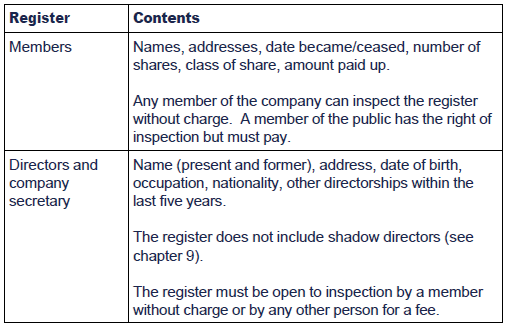
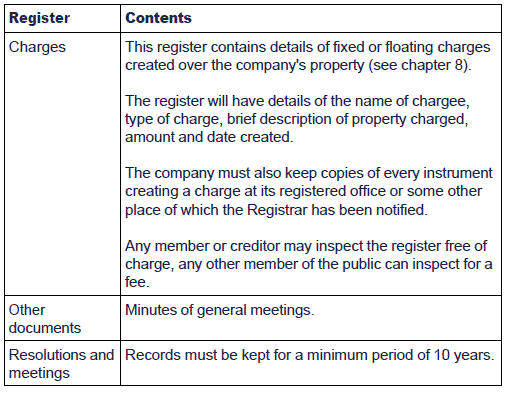
The registers must normally be kept at the company's registeredoffice (although the register of members and register of directors'interests can be kept where they are made up) and must be available forpublic inspection by a member free of charge or by any other person for afee.
Requests for inspection must provide details about the personseeking the information, the purpose of the request and whether theinformation will be disclosed to others. The company may apply to thecourt for an order that it need not comply with the request.
The register of directors' addresses should now contain serviceaddresses rather than details of the directors' residential addresses.The service address can be simply 'the company's registered office'.
The company must also keep a separate register of the directors'residential addresses. Both the service and the residential addresseswill need to be supplied to the Registrar of Companies.
The residential addresses will be withheld from the publicregister. However, they will generally remain available to the Registrarand certain specified public bodies and credit reference agencies.
Annual return
The annual return must be filed with the registrar annually within28 days of the return date (which is the anniversary of incorporation).The return must be signed by a director or a secretary. It must include:
- the address of the company's registered office
- the type of company
- the company's principal business activities
- details of directors and company secretary where applicable (see chapter 10)
- a statement of capital which states the total number of shares of the company, the aggregate nominal value of the shares and the amount paid up and unpaid on each share
- for each class of shares, the right of those shares, the total number of shares in that class and their total nominal value
- details of the members of the company as at the return date
- details of members who have ceased to become members since the last return was made
- details of the number of shares of each class held by members at the return date
Accounting records
The company must keep accounting records containing sufficientinformation to show and explain the company's transactions and itsfinancial position.
At any time it should be possible:
- to disclose with reasonable accuracy the company's financial position at intervals of not more than six months
- for the directors to ensure that any accounts that need to be prepared comply with Companies Act 2006 and International Accounting Standards.
In particular the records must show:
- daily entries of all money received and spent
- a record of assets and liabilities
- statement of stocks at end of the financial year to back up the above
- statements of stocktakng t
- statements of all goods sold and purchased, showing the goods and the buyers and sellers (except in the retail trade).
Accounting records must be kept for three years in the case of aprivate company and six years in that of a public one. They should bekept at the company's registered office or at some other place thoughtfit by the directors.
Failure to keep sufficient accounting records is an offence by the officers in default.
Annual financial statements
Companies are required to produce annual financial statements including:
- balance sheet/statement of financial position and profit and loss account/statement of comprehensive income showing true and fair view
- directors' report stating the amount of any dividend and likely future developments.
The annual financial statements must be approved and signed on behalf of the board of directors and a copy filed with Registrar.
Chapter summary
Test your understanding answers

 Test your understanding 1
Test your understanding 1
AWhereas English law treats apartnership as simply a group of individuals trading collectively, theeffect of incorporation is that a company once formed has its owndistinct legal personality, completely separate from its members.
The doctrine of separate or corporate personality is an ancientone, but the case usually cited in relation to separate personality is: Salomon v Salomon & Co Ltd (1897).Salomon had been in the boot and leather business for some time.Together with other members of his family he formed a limited companyand sold his previous business to it. Payment was in the form of cash,shares and debentures. When the company was eventually wound up it wasargued that Salomon and the company were the same, and since he couldnot be his own creditor, his debentures should have no effect. Althoughlower courts had decided against Salomon, the House of Lords held thatunder the circumstances, in the absence of fraud, his debentures werevalid. The company had been properly constituted and consequently itwas, in law, a distinct legal person, completely separate from Salomon.
A number of consequences flow from the fact that corporations are treated as having legal personality in their own right.
ILimited liability
No one is responsible for anyone else's debts unless they agreeto accept such responsibility. Similarly, at common law, members of acorporation are not responsible for its debts without agreement.However, registered companies, i.e. those formed under the CompaniesActs, are not permitted unless the shareholders agree to acceptliability for their company's debts. In return for this agreement, theextent of their liability is set at a fixed amount. In the case of acompany limited by shares, the level of liability is the amountremaining unpaid on the nominal value of the shares held. In the case ofa company limited by guarantee, it is the amount that shareholders haveagreed to pay in the event of the company being wound up.
II Perpetual existence
As the corporation exists in its own right, changes in itsmembership have no effect on its status or existence. Members may die,be declared bankrupt or insane, or transfer their shares, all withoutany effect on the company. As an abstract legal person the companycannot die, although its existence can be brought to an end through thewinding-up procedure.
IIIBusiness property is owned by the company
Any business assets are owned by the company itself and not theshareholders. This is normally a major advantage in that the company'sassets are not subject to claims based on the ownership rights of itsindividual members. It can, however, cause unforeseen problems as may beseen in Macaura v Northern Assurance Co (1925). The plaintiffhad owned a timber estate and later formed a one-man company andtransferred the estate to this company. However, he continued to insurethe estate in his own name. When the timber was lost in a fire it washeld that Macaura could not claim on the insurance as he had no personalinterest in the timber, which belonged to the company.
IVLegal capacity
The company has contractual capacity in its own right and can sueand be sued in its own name. The extent of the company's liability, asopposed to the members, is unlimited and all its assets may be used topay off debts. The company may also be liable in tort for any injuriessustained as a consequence of the negligence of its agents or employees.
V The rule in Foss v Harbottle (1843)
This states that where a company suffers an injury, it is for thecompany, acting through the majority of the members, to take theappropriate remedial action. Perhaps of more importance is the corollaryof the rule, which is that an individual cannot raise a legal action inresponse to a wrong suffered by the company.
BLifting the veil of incorporation
There are a number of occasions, both statutory and at commonlaw, when the doctrine of separate personality will not be followed. Onthese occasions it is said that the veil of incorporation, whichseparates the company from its members, is 'pierced', 'lifted' or 'drawnaside'. Such situations arise as follows:
IUnder statute
If a public company starts to trade without first obtaining atrading certificate, the directors can be made personally liable for anyloss or damage suffered by a third party: S767 CA06.
Under the Company Directors Disqualification Act 1986, if adirector who is disqualified participates in the management of acompany, that director will be jointly or severally liable for thecompany's debts.
Under the Insolvency Act 1986, members and/or directors heldliable for wrongful or fraudulent trading may be made personally liablefor losses arising as a result.
II At common law
As in most areas of law that are based on the application ofpolicy decisions, it is difficult to predict when the courts will ignoreseparate personality. What is certain is that the courts will notpermit the corporate form to be used for a clearly fraudulent purpose orto evade a legal duty. Thus in Gilford Motor Co Ltd v Horne (1933)an employee had covenanted not to solicit his former employer'scustomers. After he left their employment he formed a company to solicitthose customers and it was held that the company was a sham and thecourt would not permit it to be used to avoid the contract.
The courts are prepared to ignore separate personality in timesof war in order to defeat the activity of shareholders who might beenemy aliens. See Daimler Co Ltd v Continental Tyre and Rubber Co (GB)Ltd (1916).
Where groups of companies have been set up for particularbusiness purposes, the courts will usually not ignore the separateexistence of the various companies, unless they are being used forfraud. Although there is authority for treating separate companies as asingle group (as in DHN Food Distributors Ltd v London Borough of Tower Hamlets (1976)) later authorities have cast extreme doubt on this decision (see Woolfson v Strathclyde Regional Council (1978)).More recent cases would appear to suggest that the courts are now morereluctant to ignore separate personality where the company has beenproperly established (Adams v Cape Industries plc (1990)).


 Test your understanding 2
Test your understanding 2
(1)B
The partners of a partnership are fully liable for all of thefirm's debts. The fact that the partners in this case are limitedcompanies is irrelevant.
(2)D
Answer D gives a definition of liability for a limited liability company limited by shares.
(3)A
A shareholder is a part-owner of the company, but is not apart-owner of the property owned by the company. In law, this propertybelongs to the company itself, which is a legal person.


 Test your understanding 3
Test your understanding 3
(1)A
A public company must have at least two directors. Statements B, C and D are correct.
(2)D
A private company cannot invite the public to subscribe for itsshares. This is the key difference between a public and a privatecompany.
(3)D
A public limited company must have a name ending with the words'public limited company' (or the letters 'plc'). It may have its sharestraded publicly, but this is not a requirement of plc status. It musthave allotted share capital of £50,000, but this need not be fully paidup.


 Test your understanding 4
Test your understanding 4
A the Partnership Act 1890
do not need
…the relationship which subsists between persons carrying on a business in common with a view to profit.
B liability
members
limited
shareholders
…any unpaid portion of the price of their shares.
C more
D A public limited company must have a minimum allotted share capital of £50,000 and a trading certificate.


 Test your understanding 5
Test your understanding 5
(1)A
The company can always sue the promoter for damages. However, theright to rescission may be lost where, for example, there has beenunreasonable delay.
(2)D
Buying a company off the shelf means that the company has alreadybeen incorporated. It saves the time of going through the proceduresfor incorporation. Other non-urgent changes can then be made, such aschanging the company name. A company can be bought off-the-shelf forabout £100, which is much cheaper than using a solicitor or accountantto register a new company. However, the registered details (such as thename and directors) may need to be changed. All three statements aretherefore correct.
(3)D
The position at common law is that a company cannot be bound by acontract that was made before it was formed, and after its formation itcannot ratify or formally adopt a pre-incorporation contract. S51 CA06provides that a person acting for the company should have personalliability on a pre-incorporation contract that he enters into.
(4)A
S51 CA06 deems the person purporting to act on behalf of acompany personally liable on a pre-incorporation contract, unlessotherwise agreed. Merely signing as agent (e.g. using the words 'for andon behalf of') is not sufficient to avoid personal liability. Thecompany cannot unilaterally adopt (or 'ratify') a pre-incorporationcontract.


 Test your understanding 6
Test your understanding 6
APartners are liable for businessdebts to the extent of their personal wealth, whereas shareholders'liability is limited to the unpaid portion of their shares.
BThe company cannot make contracts before it comes into existence.
cannot
assigning the contract, making an agreement of novation or acquiring an 'off-the-shelf' company before making the contract.


 Test your understanding 7
Test your understanding 7
(1)B
Regardless of the actual date of registration, the only date that matters is the date on the certificate of incorporation.
(2)A
Provisional contracts are valid although if not paid within 21days, the directors become jointly and severally liable with thecompany.
(3)B
It is not necessary to submit articles of association and if acompany limited by shares does not do so, the model articles will apply.


 Test your understanding 8
Test your understanding 8
A joint and several
| B | IAn Application II Articles of association (unless the model articles are to apply). IIIMemorandum of association. IVA statement of capital and initial shareholdings V A statement of proposed officers containing the names of the first directors and company secretary (if applicable). VIA statement of compliance. |
CCertificate of incorporation
DAdam and Ben are only liable for any unpaid portion of the price of their shares.


 Test your understanding 9
Test your understanding 9
(1)B
S54 CA06 prohibits a company, unless given approval by theSecretary of State for the Department for Business, Enterprise andRegulatory Reform (formerly the DTI) from having a name that would belikely to give the impression that the business is carried on inconnection with the government or a local council. Here, the use of theword 'Council' in the business name would not be permitted.
(2)A
A company cannot take the same name as a company that has beenregistered already with the same name. Once registered, a company canchange its registered office, and must notify the registrar of any suchchange.
(3)B
The fact that the name ends with the letters 'Ltd' indicates that it is a private limited company.


 Test your understanding 10
Test your understanding 10
(1)C
The articles of association form a contract between theshareholders and the company, in respect of the rights of the ordinaryshareholders. The articles set out the internal regulations orconstitution of the company, e.g. the articles set out the rights ofshareholders and the powers of the directors.
(2)D
The articles of association form a contract between the ordinaryshareholders and the company, but only in respect of individual articlesthat affect the rights of the shareholders.


 Test your understanding 11
Test your understanding 11
AModel articles are prescribed bythe Secretary of State. They apply where a company is formed withoutregistering articles or where the articles registered do not exclude ormodify the model articles.
A company:
- may adopt the model articles in full or in part;
- is deemed to have adopted the model articles if there is no express or implied provision to exclude them; or
- may draft its own unique articles.
BS33 CA06 states that theprovisions of a company's constitution bind the company and its membersto the same extent as if there were covenants on the part of the companyand of each member to observe those provisions. This section has threeeffects.
IThe documents establish a contract which binds each member to the company. Thus in Hickman v Kent or Romney Marsh Sheepbreeders' Association (1920),the company was able to enforce an article against a member thatprovided that disputes involving the member and the company should go toarbitration.
II The company is contractually bound to each of its members. On this basis in Pender v Lushington (1877) a member was able to sue in respect of the wrongful denial of his right to vote at a company meeting.
IIIThe articles constitute a contract between the members. In Rayfield v Hands (1958),the articles of the company provided that, where shareholders wished totransfer their shares, they should inform the directors of the company,who were obliged to take the shares equally between them at fair value.When the directors refused to purchase the plaintiff's shares, thecourt held that the directors were bound as members by the articles andtherefore had to comply with the procedure set out there. Articles onlyoperate as a contract in respect of membership rights and obligations.Consequently it has been held that, although members can enforce them,non-members, or members suing in some other capacity than that of amember, will not be able to enforce promises established in thecompany's articles.
In Eley v Positive Government Security Life Assurance Co (1876),the articles of a company stated that the plaintiff was to be appointedas the company's solicitor. It was held that Eley could not use thearticles to establish a contract between himself and the company asthose articles only created a contract between the company and itsmembers. Although Eley was in fact a member, he was not suing in thatcapacity but in the capacity of solicitor, which was not a membershipright.
CA company can normally alterits articles by passing a special resolution. However, if certainprovisions are entrenched, they can only be altered by following thespecified procedure; this may require unanimous consent.
Any alteration must be made 'bona fide in the interest of thecompany as a whole', although the exact meaning of this phrase is notaltogether clear. It is evident that it involves a subjective element inthat those deciding the alteration must actually believe they areacting in the interests of the company. There is additionally, however,an objective element. In Greenhalgh v Arderne Cinemas Ltd (1950) it was stated that any alteration had to be in the interests of the 'individual hypothetical member'.
In Brown v British Abrasive Wheel Co (1919) an alterationto the articles of the company was proposed to give the majorityshareholders the right to buy the shares of the minority. It was heldthat the alteration was invalid as it would benefit the majorityshareholders rather than the company as a whole. However, in Sidebottom v Kershaw, Leese & Co (1920),an alteration to the articles gave the directors the power to requireany shareholder, who entered into competition with the company, totransfer their shares to nominees of the directors at a fair price. Itwas held that under those circumstances the alteration was valid as itwould benefit the company as a whole.

|
Created at 5/24/2012 2:47 PM by System Account
(GMT) Greenwich Mean Time : Dublin, Edinburgh, Lisbon, London
|
Last modified at 5/25/2012 12:54 PM by System Account
(GMT) Greenwich Mean Time : Dublin, Edinburgh, Lisbon, London
|
|
|
|
 |
Rating
:
|
 Ratings & Comments
(Click the stars to rate the page) Ratings & Comments
(Click the stars to rate the page)
|
 |
Tags:
|
|
|
|
|